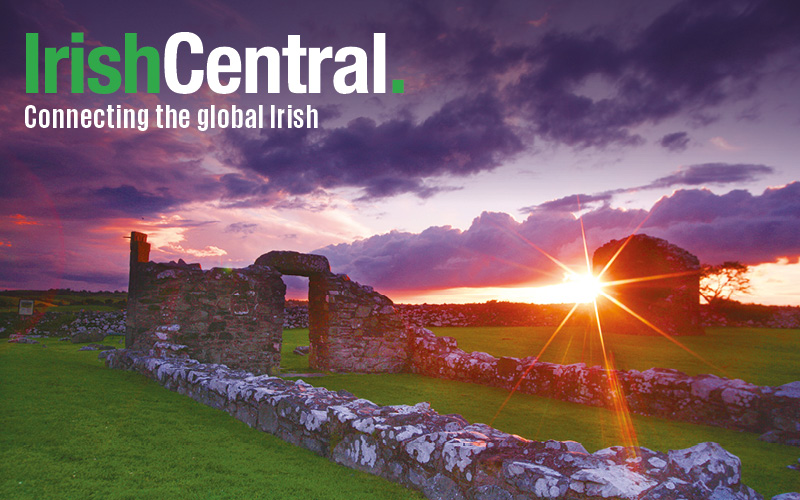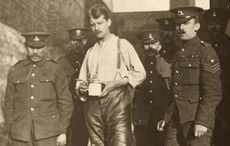PHOTOS - See the 10 places where Ireland's scariest ghosts reside
Ireland has a long and bloody history, which means that naturally, haunted places can be found all over the country.
From castles visited by murdered spirits, to pubs run by friendly ghosts, Ireland is home to an array of specters.
We’ve done our research here at IrishCentral and come up with what we think are the 10 most haunted places in all of the Emerald Isle.
So light a fire, curl up to your computer and get ready to learn all about the Ireland’s scariest ghouls and ghosts.
Read more on our featured Halloween page - everything from history, recipes, costume ideas and ghoulish tales
1. Ross Castle
Lough Sheelin, County Meath
A famous Irish building steeped in history, Ross Castle is known as one of the most haunted places in all of Ireland and even Britain.
Located on the shores of Lough (Lake) Sheelin, the castle was built in 1533 by the Lord of Devon Richard Nugent, a.k.a. the Black Baron.”
The Baron’s tragic daughter Sabina is said to haunt the property today.
Legend has it that in 1536, Sabina met a handsome young man named Orwin, son of an O’Reilly chieftain, on a bridge on the edge of her father’s property.
The two fell in love, but they weren’t considered an appropriate match, with Sabina being English and Orwin being Irish.
So the star-crossed lovers decided to elope, and took a boat out onto Lough Sheelin to escape the people who wouldn’t accept them together.
But the unpredictable lake waters got the best of them when a storm hit and their boat was overturned. Orwin struck his head on the rock beneath the shallow lake and died, while Sabina was rescued.
When Sabina woke up three days later and saw her beloved’s body laid out in the palace chapel, she screamed a blood curdling scream. Soon after she died from shock, and she and Orwin were buried in a mound on the castle grounds.
Sabina now haunts Ross Castle, in search for her lost lover. Her agonizing wail is said to still be heard today around 3 or 4 a.m. in the back right room of the castle.
The Black Baron’s presence has also been reported visitors in the vicinity of the castle on numerous occasions. The Baron is said to roam the grounds as well, grieving for his dead daughter.
2. Kilmainham Gaol
Kilmainham, County Dublin
Prisons are famously haunted buildings, and Ireland’s most famous prison is no exception.
Kilmainham Gaol in Dublin opened in 1796, and is the place where the leaders of the 1916 Easter Rising were held and subsequently executed by firing squad. The building was shut down in 1924.
Today, the large and eerie jail is Ireland’s largest unoccupied prison. It was restored in the 1960s, and is now a museum that’s said to be haunted by both former inmates and evil wardens.
Several ghostly tales have been told about Kilmainham Gaol. During its restoration, caretaker Dan McGill reported lights mysteriously turning on and off in the prison chapel.
During the same time period, a man who was painting the dungeon area of the prison experienced a powerful gust of wind, which blew him against a wall. The man managed to fight his way out of the dungeon, and emerged with an ashen face and shaking hands. He refused to work in, or ever enter, the jail again.
Another worker was decorating the 1916 memorial corridor when he heard heavy footsteps climbing the stone stairs and walking up behind him. When he turned, no one was in the corridor, despite the fact that the footsteps continued right past him.
Several children who went to tour the prison have stopped at its threshold and refused to go a step further onto the grounds.
According to Dan McGill, the threatening spirits at the prison do not belong to the inmates, because they are happy that their stories are being told. But, “The soldiers and the guards?” he would say. “Now they’re a different matter.”
PHOTOS - See the 10 places where Ireland's scariest ghosts reside
3. Charles Fort
Kinsale, County Cork
Military forts join theatres and jails in being the most haunted areas in many countries.
Charles Fort is Ireland’s resident military haunted sight.
The fort, which was built in the 1670s, is often visited by the “White Lady of Kinsale.”
The legend goes like this: In the 1870s, Wilful Warrender was a young woman married to an officer named Sir Trevor Ashurst.
One day, Ashurst swapped places with a sentry, who he sent to fetch flowers on his wedding day.
Wilful’s father, the commander of the fort, saw the “sentry” asleep, and shot him, only realizing afterwards that he had actually killed his new son-in-law.
When Wilful discovered what had happened, she leapt to her death from the battlements, prompting Commander Warrender to shoot himself.
Ever since, Wilful, the “White Lady of Kinsale,” has roamed the grounds of Charles Fort, and has been seen walking through locked doors.
Read more on our featured Halloween page - everything from history, recipes, costume ideas and ghoulish tales
4. Charleville Castle
Tullamore, County Offaly
Charleville Forest Castle is so famously haunted that it’s been featured on shows such as Fox's “Scariest Places On Earth” and Living TV's “Most Haunted.”
The Irish castle has been visited by numerous paranormal investigators and psychics, and many of its guests have reported strange happenings in the castle during their stay.
Charleville Castle was built in 1798 for the first Earl of Charleville William Bury and his family. The castle remained in the Bury family until 1963, when Colonel Charles Howard Bury suddenly dropped dead.
Today, a woman named Bridget Vance owns the property and is restoring the castle to its original Gothic Revival beauty.
Castle workers say construction has awakened the spirits of Charleville. They report having heard strange whispering voices and classical music throughout the castle.
Many have also heard the sounds of children playing in a room of the castle that was once the nursery.
According to legend, a little girl named Harriet died a tragic death at Charleville while playing in the stairwell in the early 1800s.
Harriet’s ghost has been seen in the stairwell, and people have said they felt a cold brush of wind brush past them as they descend these steps. The little girl can be heard in rooms around the castle, moving furniture and giggling and talking.
But children aren’t the only spirits to haunt Charleville.
The famous castle is said to have been built on land that was once an ancient druid stomping ground, and the Vance family reports having seen ghostly hooded figures around the castle grounds.
5. St. Michan’s Church
Dublin
St. Michan’s in Dublin is famous for many reasons. The church, built in 1095, contains the death mask of the Irish patriot Wolfe Tone and the organ on which Handel practiced his masterpiece “Messiah” before his first performance in Dublin.
The renowned Anglo-Irish philosopher Edmund Burke was christened here, while legendary nationalist political leader Charles Stewart Parnell’s funeral took place here.
But St. Michan’s is well-known for being haunted as well as the home of the Mummies of St. Michan.
The dark church vaults contain remarkably preserved corpses, including those of a 400-year-old nun, brothers and leaders of the 1798 Irish rebellion John and Henry Sheares and a body with severed hands and feet.
Though the cadavers in the crypt are cold and clammy, the air in the space is oddly warm, which makes it strange that many visitors report having felt icy cold fingers run down their necks as they stoop to examine the corpses.
Others say they’ve heard disembodied whispering voices around them, while others simply have felt a strange, cold presence.
6. Grand Opera House
Belfast
The magnificent Grand Opera House was opened in Belfast in 1895. Though the building was damaged during the Troubles, it has since been restored to its original splendor.
Several ghosts haunt the theatre, but sadly, most of them are unidentified.
Cast members have often seen a face looking in at them from a round window on their way down from the dressing rooms on the top floor. Opera House staff members have also reported a feeling that someone was behind them when nobody was there, especially while standing on stage.
Actors say they often feel like they’re being followed in the stage area, and the most commonly spotted specter at the theatre is a mysterious figure in a long, black hooded cloak that is always seen on stage. Some think the ghost to be a former actor, still waiting for the curtain to go down on his final role.
The Northern Ireland Paranormal Research Association recently investigated the Grand Opera House, and claim to have come in contact with the spirits of Harry and George, a pair of deceased stage hands who worked at the theatre in the 1980s.
Ghost hunters have also identified an unnamed woman who used to clean the building and an anonymous electrician who used to work for the Opera House.
7. Renvyle House Hotel
Connemara, County Galway
Today, Renvyle House in Galway is a charming rural hotel, but its guests, including William Butler Yeats, have experienced frightening ghostly happenings within this charming home’s walls.
The hotel has an eventful history, having been burned to the ground by the IRA in the 1930s.
Before this, the famous Dublin surgeon and poet Oliver St. John Gogarty owned the property.
Several of Gogarty’s servants reported fearful “presences” in the home, and reported bedsheets inexplicably flying off beds and doors opening and closing on their own.
One night, Gogarty even experienced a ghostly presence himself.
The Irishman was woken up by heavy, limping footsteps along the hallway, slowly approaching his door. Gogarty lit a candle and went to investiage the strange noises, but as soon as he entered the corridor, the flame blew out and he was alone in the dark.
Gogarty said his limbs became heavy, as if he “were exercising with rubber ropes.”
The supernatural activity at Renvyle increased when Gogarty’s close friend Yeats and his wife Georgia came to stay.
Yeats and his companions were sitting in the library at the home, when the door suddenly creaked wide open. Though his friends were terrified, Yeats raised his hand and shouted, "Leave it alone, it will go away, as it came.” The door then slammed shut.
The Yeats later held a séance, in which a vapory mist appeared, and eventually assumed the form of a red-haired, pale-faced boy who looked to be about 14. "He had the solemn pallor of a tragedy beyond the endurance of a child," Georgia Yeats later said, and discovered that the boy was a member of the Blake family, who originally owned the house.
Renvyle House was soon after burnt to the ground by the IRA, but it was rebuilt, and ghosts are said to still roam its corridors today.
PHOTOS - See the 10 places where Ireland's scariest ghosts reside
8. Grace Neill’s Bar
Donaghadee, County Down
Grace Neill’s in County Down is one of the oldest pubs in Ireland.
Built in 1611, the pub was originally known as “The King’s Arms,” but was renamed after Grace Neill, who ran the inn for many years until her death in 1918 at the age of 98. Neill was an Irish woman with a big personality, and liked to keep a watchful eye on things at the inn.
But Grace hasn’t let her death interfere with her work at the pub.
A ghost of an old woman in Victorian clothing has been spotted in dark corners of the inn, and her spirit can be seen at the front bar, straightening glasses and furniture and switching lights on and off.
A strange shuffling can often be heard coming from the second floor, and some have even felt an invisible “presence” pass through them while standing near the building’s staircase.
But patrons visiting Grace Neill’s have nothing to worry about – the former caretaker of the inn is as friendly as ghosts come!
Grace ran a welcoming establishment while she was alive, and continues to do so in her afterlife.
PHOTOS - See the 10 places where Ireland's scariest ghosts reside
Originally published October 2009.




Comments